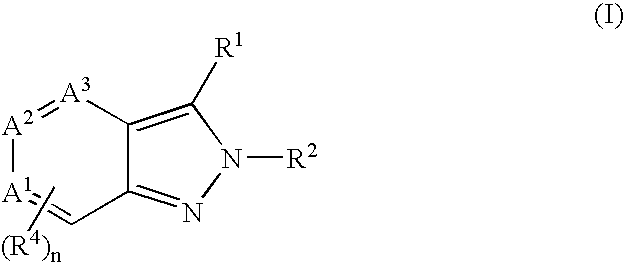Heterocyclic GABAA subtype selective receptor modulators
a selective receptor and heterocyclic gabaa technology, applied in heterocyclic compound active ingredients, drug compositions, biocide, etc., can solve the problems of sedation, dependence, ataxia, sedation is undesirable in anxiolytic agents, and limited use, so as to prevent or treat disorders.
- Summary
- Abstract
- Description
- Claims
- Application Information
AI Technical Summary
Benefits of technology
Problems solved by technology
Method used
Image
Examples
example 1
7-Bromo-2H-indazole
[0159]
Step 1
[0160] 3-Bromo-2-nitrotoluene (Scheme 1; 1c)—A mixture of copper(II) bromide (3.52 g, 15.7 mol) in 20 mL dry acetonitrile was heated to 65° C. under an N2 atmosphere. t-Butyl nitrite (2.35 mL, 2.03 g, 19.7 mmol) was added all at once. A solution of 3-methyl-2-nitroaniline (1b; 2.00 g, 13.1 mmol; J Org Chem. 1976 41(21):3357) in 15 mL acetonitrile was added to the above solution at a rate to sufficient to maintain gentle reflux. After addition the mixture was heated at a gentle reflux for an additional 15 m. The reaction mixture was cooled to rt and partitioned between 6N HCl solution (150 mL) and ether (150 mL). The ethereal solution was separated and washed with brine, then dried over MgSO4. Evaporation of the solvent afforded 2.76 g of impure material, which was flash chromatographed on SiO2 and eluted with 10% acetone in hexane which afforded 1.62 g (57%) of 1c as a pale yellow-green liquid.
Step 2
[0161] 2-Bromo-6-methylaniline (2a)—A mixture o...
example 2
7-(2,4-Dichloro-phenyl)-2-methyl-2H-indazole
[0164]
5 (Ar=2,4-dichlorophenyl; R=Me)
Step 1
[0165] A solution of 7-bromo-1H-indazole (3; 1.01 g, 5.13 mmol) and tetrakis(triphenylphosphine) palladium(0) (0.176 g, 0.152 mmol) in 15 mL of ethylene glycol dimethyl ether was stirred for 30 m. To the solution was added 2,4-dichlorophenyl boronic acid (1.93 g, 10.1 mmol) and a 2 M aqueous Na2CO3 solution (7.1 mL, 14.2 mmol). The orange-yellow mixture was stirred at 80° C. for 19 h, allowed to cool, then partitioned between 50 mL of ethyl acetate and 50 mL of water. The organic layer was dried over MgSO4, filtered, and concentrated to an orange oil. Column chromatography (0→10% EtOAc / hexanes) afforded of 7-(2,4-dichloro-phenyl)-1H-indazole as a pale yellow foamy solid (4; 1.12 g, 83%).
Step 2
[0166] A solution of 7-(2,4-dichloro-phenyl)-1H-indazole (4; 1.12 g, 4.27 mmol) and dimethyl sulfate (0.405 mL, 4.28 mmol) in 15 mL of toluene was stirred at 110° C. for 17 h, allowed to cool, then chi...
example 3
7-(2,4-Dichloro-phenyl)-2,3-dimethyl-2H-indazole; hydrochloride
[0169]
Step 1
[0170] A solution of 7-bromo-1H-indazole (3; 1.71 g, 8.67 mmol) and dimethyl sulfate (0.90 mL, 9.5 mmol) in 30 mL of toluene was stirred at 110° C. for 4 h, then allowed to cool. The mixture was carefully washed with 30 mL of a saturated aqueous NaHCO3 solution, dried over MgSO4, filtered (rinsing with diethyl ether), and concentrated to an orange oil Column chromatography (0→50% EtOAc / hexanes) afforded 7-bromo-2-methyl-2H-indazole (6: R=Me; 1.33 g, 73%) as a light tan solid.
Step 2
[0171] To a solution of 7-bromo-2-methyl-2H-indazole (5.49 g, 26.0 mmol) in 100 mL of THF at −78° C. was added a 2.0 M solution of lithium diisopropylamide in THF / heptane / ethylbenzene (19.5 mL, 39.0 mmol). The resulting dark orange solution was stirred at 0-5° C. for 15 m, then rechilled at −78° C. for 15 m. Iodomethane (2.5 mL, 40 mmol) was added, and the orange solution allowed to slowly warm to RT over 17 h period with stir...
PUM
| Property | Measurement | Unit |
|---|---|---|
| temperature | aaaaa | aaaaa |
| temperature | aaaaa | aaaaa |
| temperature | aaaaa | aaaaa |
Abstract
Description
Claims
Application Information
 Login to View More
Login to View More - R&D
- Intellectual Property
- Life Sciences
- Materials
- Tech Scout
- Unparalleled Data Quality
- Higher Quality Content
- 60% Fewer Hallucinations
Browse by: Latest US Patents, China's latest patents, Technical Efficacy Thesaurus, Application Domain, Technology Topic, Popular Technical Reports.
© 2025 PatSnap. All rights reserved.Legal|Privacy policy|Modern Slavery Act Transparency Statement|Sitemap|About US| Contact US: help@patsnap.com



